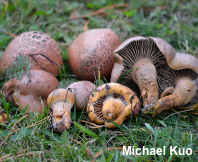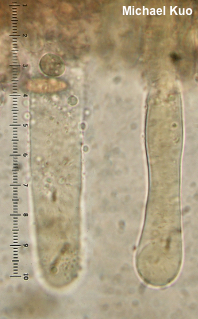| Major Groups > Gilled Mushrooms > Dark-Spored > Chroogomphus > Chroogomphus subfulmineus |

|
Chroogomphus subfulmineus [ Basidiomycota > Boletales > Gomphidiaceae > Chroogomphus . . . ] by Michael Kuo Found under two-needle pines in Europe, Chroogomphus subfulmineus is a particularly large species of Chroogomphus, characterized by the purplish red fibers on its thick stem, the slightly olive flesh in the stem base, and microscopic features, including large spores and cystidia that are wide and thin-walled. The species was only recently named, on the basis of DNA results (Scambler et al. 2018); previously it has been included in treatments of Chroogomphus rutilus and Chroogomphus britannicus. Chroogomphus subfulmineus is not known to occur in North America. The only North American species regularly approaching its dimensions is Chroogomphus pseudovinicolor, which differs in associated trees and features thick-walled cystidia. Description: Ecology: Mycorrhizal with Scots pine (Pinus sylvestris) and Austrian pine (Pinus nigra); growing gregariously in late summer and fall; originally described from Cyprus and Scotland; possibly to be expected throughout the natural ranges of the host trees (Europe, western Asia). The illustrated and described collection is from Italy. Cap: 5–9 cm wide; convex becoming broadly convex; sticky when young and fresh but soon dry; at first dull orange overall, but soon darkening to reddish or purplish red, with an orange marginal area; eventually dull grayish brown; innately sub-fibrillose; thick. Gills: Running down the stem, or beginning to do so; distant or nearly so; thick; short-gills frequent; at first pale dull orangish; darkening to grayish olive or grayish brown with maturity. Partial Veil: Initially a whitish to yellowish cortina stretched between the cap margin and stem; eventually disappearing. Stem: 3–8 cm long; 1.5–3 cm thick; tapering to base; orangish and fairly smooth near the apex, with a pink to reddish zone below the orange; below yellowish to orange underneath red to purplish red fibrils and scales; basal mycelium dull yellow to orange. Flesh: Yellow to orangish; dull olive in the stem base. Odor: Not distinctive. Spore Print: Olive brownish. Microscopic Features: Spores 17–21 x 6–8 µm; boletoid-fusiform; smooth; yellow-brown in KOH; brownish in Melzer's Reagent. Basidia 50–65 x 8–10 µm; clavate; 4-sterigmate. Pleurocystidia 80–110 x (12.5–) 15–25 µm; cylindric (occasionally subfusiform, subclavate, or subutriform) with rounded apices; smooth; thin-walled; brownish in KOH. Cheilocystidia similar to pleurocystidia. Lamellar trama amyloid. Pileipellis an ixocutis; elements 3–5 µm wide, smooth or a little encrusted, occasionally amyloid, brown in KOH. REFERENCES: T. Niskanen, M. Loizides, R. Scambler & K. Liimatainen, 2018. (Scambler et al., 2018; Saitta et. al, 2020.) Herb. Kuo 10141414. This site contains no information about the edibility or toxicity of mushrooms. |
© MushroomExpert.Com |
|
Cite this page as: Kuo, M. (2021, October). Chroogomphus subfulmineus. Retrieved from the MushroomExpert.Com Web site: http://www.mushroomexpert.com/chroogomphus_subfulmineus.html |



